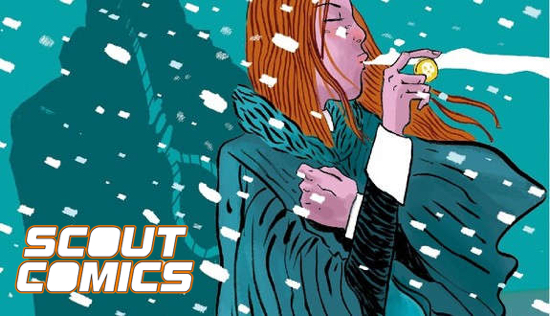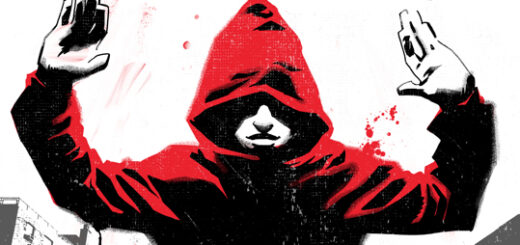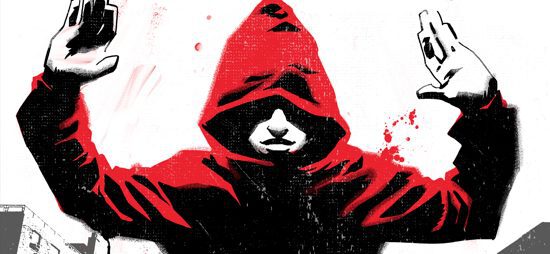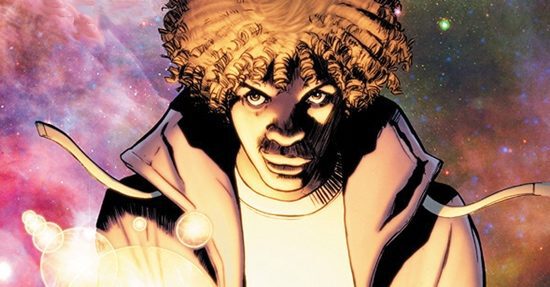Joe Corallo: Ben Kahn’s Heavenly Blues
Over the past few weeks, I’ve been highlighting some of the newer publishers, including Vault Comics, AfterShock Comics, and It’s Alive! Press.
This week I’m covering Scout Comics and Ben Kahn. Ben had self-published a comic titled Heavenly Blues which I had picked up a while back at Carmine Street Comics here in Manhattan. Since then, Scout Comics has picked up the series. I got the chance to talk with Ben about his comics career and having Heavenly Blues added to Scout Comics growing roster.
JC: Thank you for taking the time to chat with me about your new series at Scout Comics, Heavenly Blues! Before we get started, you’re a fairly new face to comics, at least in terms of being Diamond distributed. Can you tell us a bit about your writing career leading up to this?
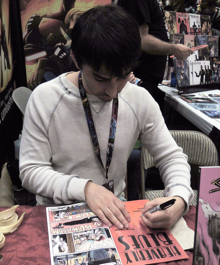 BK: Of course. Heavenly Blues is my first series handled by Diamond, but my work in comics stretches back over twelve years. In high school, I worked on a webcomic that ran for around 700 strips between 2005 and 2012. It wasn’t much. I took video game sprites and used them to make comics in MSPaint and Photoshop. For a shock-comedy webcomic it was pretty successful, but that’s not exactly setting the bar very high. I loved working on the webcomic and making it taught me a lot about writing dialogue, but it eventually just kinda ran out of steam. A big part of that was I had started working on Shaman. Production on Shaman ran from 2011 to 2015, when it was released. Shaman was actually distributed by Diamond as a trade paperback. So Heavenly Blues is my first series in Diamond, but it’s not my first rodeo with them. While I was working on Shaman, I was also working as a writer and designer for a mobile game company. Don’t ask me what games I worked on, they were all terrible. But working on those games gave me the resources to make Shaman, so all’s well that ends well.
BK: Of course. Heavenly Blues is my first series handled by Diamond, but my work in comics stretches back over twelve years. In high school, I worked on a webcomic that ran for around 700 strips between 2005 and 2012. It wasn’t much. I took video game sprites and used them to make comics in MSPaint and Photoshop. For a shock-comedy webcomic it was pretty successful, but that’s not exactly setting the bar very high. I loved working on the webcomic and making it taught me a lot about writing dialogue, but it eventually just kinda ran out of steam. A big part of that was I had started working on Shaman. Production on Shaman ran from 2011 to 2015, when it was released. Shaman was actually distributed by Diamond as a trade paperback. So Heavenly Blues is my first series in Diamond, but it’s not my first rodeo with them. While I was working on Shaman, I was also working as a writer and designer for a mobile game company. Don’t ask me what games I worked on, they were all terrible. But working on those games gave me the resources to make Shaman, so all’s well that ends well.
JC: I’d like to expand on what you were discussing regarding Shaman. As someone whose self-published before I understand how daunting of a feat that can be. How did you go about making that happen and what were the challenges and rewards for you?
BK: Making Shaman was one of the most difficult, and rewarding things I’ve ever done. It’s a five-chapter graphic novel that I worked on with Bruno Hidalgo (who is working with me again on Heavenly Blues) and was about a necromancer and his teenage daughter going on crazy adventures and bringing heroes and villains back to life. Think Hellblazer meets Rick & Morty. I was very lucky to work with Philly-based publisher, Locust Moon Press. They helped me put together a creative team, find artists for covers (including Farel Dalrymple, JG Jones, and Jim Rugg). Really, they taught me everything I know about making comics. To get the book actually printed and into stores, I had to do a Kickstarter campaign. The campaign was successful, but man was that the toughest month of my life. Kickstarter’s great. The stories and creative voices it’s empowered are truly something to behold. But man oh man am I happy that I don’t have to do another Kickstarter. I’m so proud of the work Bruno and I did on Shaman. It was my first real comic book, the first time I really got to see characters I imagined come to life. It was beyond rewarding, and not just because seeing your book in a store in between Saga and Spider-Man is the coolest thing ever.
JC: Okay, now onto Heavenly Blues! How did you come about thinking up this idea, and at what point did your collaborator Bruno Hidalgo join the project?
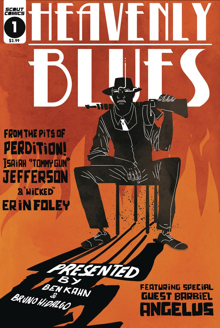 BK: The original kernel of an idea was an old Irish proverb “may you be in Heaven half an hour before the devil knows you’re dead.” It got me thinking of a heist on Heaven, where thieves had 30 minutes to break in and make the ultimate score. The story naturally moved away from that idea, but that’s where the idea of “heist in the afterlife” started. Rather than having present day, alive characters break into heaven, I realized that the characters could be much more varied and complex if they were already dead. Bruno came on board the very second there was a script done. He was the only artist I wanted to work with on this. There was almost no downtime between Shaman ending and Heavenly Blues beginning.
BK: The original kernel of an idea was an old Irish proverb “may you be in Heaven half an hour before the devil knows you’re dead.” It got me thinking of a heist on Heaven, where thieves had 30 minutes to break in and make the ultimate score. The story naturally moved away from that idea, but that’s where the idea of “heist in the afterlife” started. Rather than having present day, alive characters break into heaven, I realized that the characters could be much more varied and complex if they were already dead. Bruno came on board the very second there was a script done. He was the only artist I wanted to work with on this. There was almost no downtime between Shaman ending and Heavenly Blues beginning.
JC: Like Shaman, you went about self-publishing Heavenly Blues at first. Why did you decide on the self-publishing route for this series?
BK: Self-publishing was never the end goal. The idea was always to do a small print run to get the word out there while I pitched to publishers. Part of the reason I wanted to do a print run before pitching to publishers was to build up some early awareness and buzz. Judging by the existence of this interview, it worked! With Shaman, I wanted to have all five issues done before printing. But with Heavenly Blues, I decided to do a small print run of the individual issues. Part of this was wanting more content for conventions, and part was seeing just how easy it was when my life partner did it (Kathleen Kralowec of the wonder The Lion & The Roc webcomic).
JC: When did you decide to pitch the series around and why is Scout Comics the best home for Heavenly Blues?
BK: Pitching was always the plan. From day one, I wanted Heavenly Blues to have a real publisher. It was the same with Shaman. I pitched it to every comics publisher there was, but even though we got really close with some, it didn’t work out. But I pitched Shaman back in 2013 and 2014. And even though that feels like such a short time ago, the comic industry has really changed in just the last couple of years. There’s a whole new tier of publishers that just didn’t exist when I pitched Shaman. No Scout, no Black Mask Studios, no AfterShock Comics, no Vault Comics. Heavenly Blues simply entered a very different environment than Shaman did. I had a couple of publishers interested in Heavenly Blues, but Scout really impressed me from the get-go. Brendan Deneen and James Pruett have been fantastic to work with. Scout is young and hungry, and is putting out some really spectacular books like Solar Flare, Mindbender, InferNoct, and Girrion. It’s a library I’m very proud to be a part of.
JC: Some of the characters we see in Heavenly Blues are based somewhat on real people. What about those people and events in history inspired you to write this story?
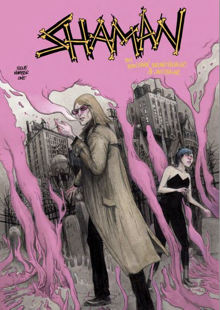 BK: The nature of the story gives me access to all of history. I wanted to create the “ultimate” team of thieves and wanted to pull from the most iconic archetypes from around the world. I didn’t want to use real historical people though, I wanted more freedom in establishing their personalities and backstories. Some characters are based off more generic archetypes, like 16th-century ninja Hideki Iwata and ancient Egyptian grave robber Amunet. Others are inspired by more specific people. With the main character, Isaiah Jefferson, he’s a bank robber from the Great Depression. He very much follows in the John Dillinger model of the Criminal as Celebrity. Wild West outlaw, James ‘Coin Counter’ Turner, was based heavily on Doc Holliday with some notable differences (namely Coin Counter’s less than heroic morality and his queer sexuality). I think Erin Foley’s inspiration is the most interesting to me, as she doesn’t originate from a traditional ‘thief’ archetype. Instead, she comes from the character Pearl in Scarlet Letter. Scarlet Letter was one of my favorite books in high school, and I was excited at the opportunity to explore that kind of time period and culture.
BK: The nature of the story gives me access to all of history. I wanted to create the “ultimate” team of thieves and wanted to pull from the most iconic archetypes from around the world. I didn’t want to use real historical people though, I wanted more freedom in establishing their personalities and backstories. Some characters are based off more generic archetypes, like 16th-century ninja Hideki Iwata and ancient Egyptian grave robber Amunet. Others are inspired by more specific people. With the main character, Isaiah Jefferson, he’s a bank robber from the Great Depression. He very much follows in the John Dillinger model of the Criminal as Celebrity. Wild West outlaw, James ‘Coin Counter’ Turner, was based heavily on Doc Holliday with some notable differences (namely Coin Counter’s less than heroic morality and his queer sexuality). I think Erin Foley’s inspiration is the most interesting to me, as she doesn’t originate from a traditional ‘thief’ archetype. Instead, she comes from the character Pearl in Scarlet Letter. Scarlet Letter was one of my favorite books in high school, and I was excited at the opportunity to explore that kind of time period and culture.
JC: You tackle elements of Christianity in this story. Since that can be a sensitive subject for some people, how do you go about writing a story with a religious backdrop?
BK: Honestly, the religious aspect never really factored into it. I’m Jewish. Heaven and Hell were never presented to me in a religious context. The afterlife isn’t a big deal in Jewish culture. It’s almost never mentioned, and when it is there are very few details. When I was first told about Heaven and Hell, I had so many questions that there were no answers to. So Hell is just the torture dimension? Who decides who goes where? Does judgment change with modern morality, or is it fixed? Heaven and Hell never seemed like real places that people could exist in, so this is my attempt at answering those questions and creating an afterlife that feels, for lack of a better word, real. I think by now people have been exposed to dozens if not hundreds of depictions of Heaven and Hell that are relatively secular. And if someone is offended…*shrug*
JC: What comics and comic writers influence your work and made you want to get into comics in the first place?
BK: Oh man, I was just thinking about this today. Now I actually get to tell you my comics Mt. Rushmore: Neil Gaiman, Grant Morrison, Brian K Vaughn, and Geoff Johns. They each influenced me in major ways. Vaughn’s Runaways was the first comic I ever read, Johns’ Green Lantern was my first superhero series I followed month to month, Gaiman’s Sandman inspired me to become a writer, and Morrison’s everything turned my reality into a fragmented kaleidoscope of dream time. I think comics are greatest creative medium ever invented. I think it’s the perfect union of incredible writing and incredible art. I think every medium has its specialties and what it does best, but what comics do better than anything else is depict the impossible. An epic battle of the gods among the cosmos is just as easy to depict as two people talking in a diner, maybe easier. There’s absolutely nothing that can’t be done in comics, and that inspires me every day.
JC: What advice can you give to all the self-publishers that may be reading this?
BK: What advice can I give? Be obsessed. Like, crazy obsessed. Unhealthily obsessed. Be prepared to forgo social events and spend ludicrous amounts of money on a creative team. You want a professional book? Gotta pay people a professional rate. There’s no cheat or shortcut. I truly believe comics aren’t something you can do unless you’re willing to throw absolutely everything you’ve got at it. But if you’re obsessed enough, that’ll be a price you’ll pay without a second thought.
JC: Thanks again for taking the time to chat with me! Where can people pre-order Heavenly Blues and do you have anything else you’d like to plug?
BK: Heavenly Blues is out in stores on July 26th, and the Diamond order code is MAY171769. You can find Shaman on ComiXology or on my Etsy store. My next convention is Five Points Comics Festival, so catch me there in New York this weekend on May 20-21st. And make sure to check out all the other great books from Scout Comics!


